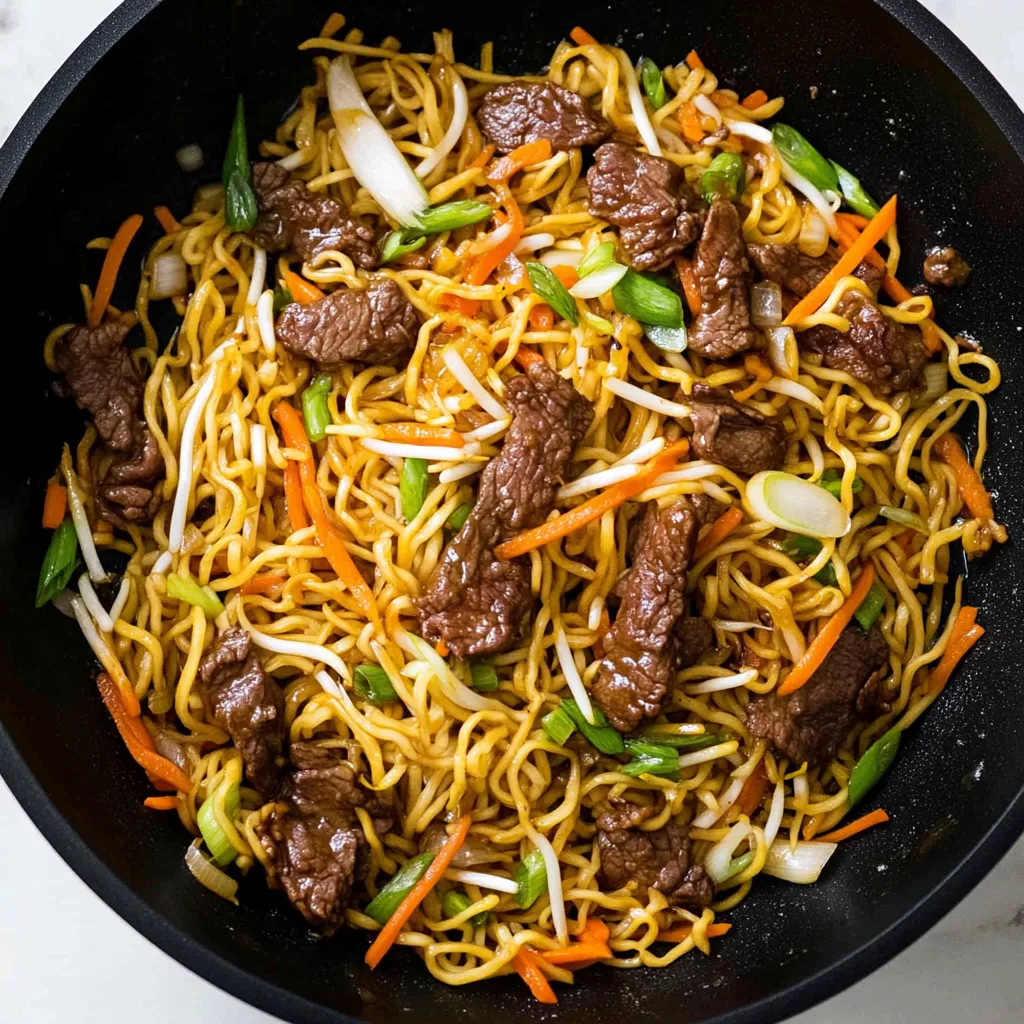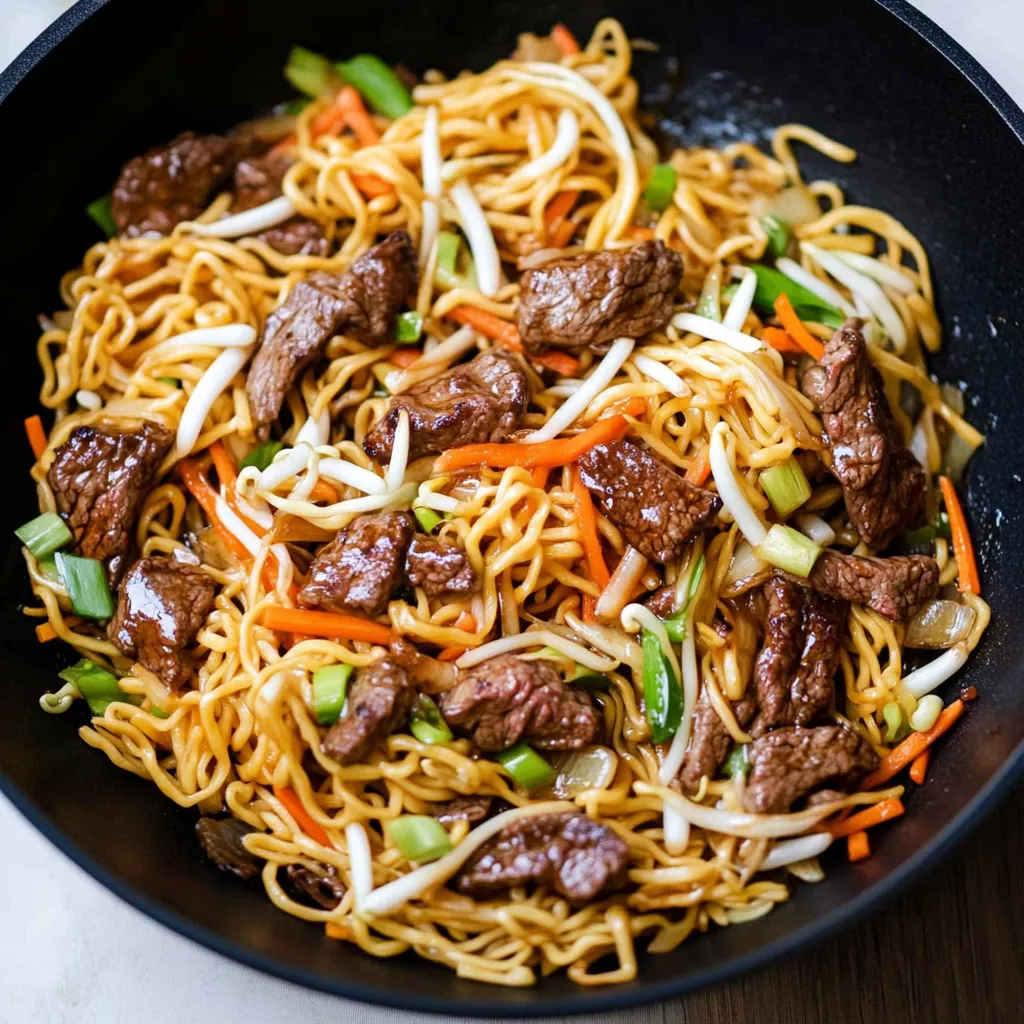 Pin it
Pin it
This incredibly flavorful beef chow mein brings together tender strips of marinated beef, crispy vegetables, and perfectly chewy noodles in a savory sauce that's so much better than takeout. Ready in under 30 minutes, this classic Chinese dish delivers restaurant-quality results with that perfect balance of textures and umami-rich flavors that make every bite absolutely satisfying.
I absolutely love making this beef chow mein because it transforms simple ingredients into something that tastes like it came from my favorite Chinese restaurant, but with so much more flavor and freshness. The key lies in understanding that chow mein literally means "fried noodles" in Chinese, and when you get that high-heat stir-frying technique right, magic happens in the wok. My family requests this dish constantly because it delivers that perfect combination of comfort and excitement that makes dinner feel special.
Ingredients and Why They Matter
- Thin egg noodles (chow mein noodles): provide that characteristic chewy texture and yellow color that's essential for authentic chow mein
- Tender beef sirloin or ribeye: creates succulent, flavorful strips that stay juicy when sliced properly and cooked quickly
- Oyster sauce: brings incredible umami depth and richness that's absolutely essential for authentic flavor
- Fresh garlic and shallots: provide aromatic foundation that's much more delicate and suitable than regular onions
- Bean sprouts: add that essential crispy crunch and fresh texture that makes each bite interesting
- Green onions: contribute distinct flavor and beautiful color that can't be replicated with regular onions
- Matchstick carrots: bring sweetness, color, and satisfying crunch to balance the rich beef and sauce
- Sesame oil and rice wine: create authentic Chinese flavors with nutty depth and subtle complexity
Step-by-Step Instructions
- Marinate the beef first:
- Slice 1 pound of sirloin or ribeye into thin strips against the grain, then marinate in 2 tablespoons oyster sauce and 1 tablespoon cornstarch for 10 minutes. This brief marination tenderizes the meat and adds flavor without requiring long preparation time.
- Prepare the chow mein noodles:
- Bring a large pot of water to boil and cook 8 ounces of dried chow mein noodles according to package directions until just tender. Drain immediately and rinse with cold water to stop cooking, then toss with 1 tablespoon vegetable oil to prevent sticking.
- Mix the stir-fry sauce:
- In a small bowl, whisk together 3 tablespoons oyster sauce, 2 tablespoons low-sodium soy sauce, 1 tablespoon sesame oil, 1 tablespoon rice wine, and 1 teaspoon granulated sugar until smooth. Having this ready before you start cooking is crucial for success.
- Prepare all vegetables:
- Mince 3 garlic cloves, slice 2 shallots thinly, cut 3 green onions into 1-inch pieces, and have 1 cup matchstick carrots and 1 cup bean sprouts ready. Everything should be prepped and within arm's reach before you start cooking.
- Heat your wok or large skillet:
- Get your wok screaming hot over high heat - this is absolutely essential for proper stir-frying. The pan should be so hot that a drop of water immediately sizzles and evaporates.
- Sear the beef quickly:
- Add 1 tablespoon oil to the hot wok, then immediately add the marinated beef in a single layer. Let it sear for 15-20 seconds without moving it, then stir-fry for another 30-60 seconds until just cooked through but still tender. Remove beef immediately and set aside.
- Stir-fry the aromatics:
- Add another tablespoon of oil to the wok, then stir-fry the garlic, shallots, and white parts of green onions for 30 seconds until fragrant but not browned.
- Add vegetables and noodles:
- Add the carrots and stir-fry for 30 seconds, then add the cooked noodles, tossing everything together with tongs or two spatulas to combine evenly.
- Add sauce and finish:
- Pour the prepared sauce over the noodles and toss to coat everything evenly. Add the bean sprouts and green onion tops, stir-frying for another 30 seconds until the sprouts are just heated through but still crispy.
- Return beef and serve:
- Add the cooked beef back to the wok and toss everything together one final time, just until the beef is reheated. Remove from heat immediately and serve hot while everything is at peak texture and temperature.
 Pin it
Pin it
I learned the importance of proper heat and timing the hard way when I first started making this dish. My early attempts resulted in soggy noodles and tough beef because I was cooking everything too slowly and for too long. Once I understood that authentic stir-frying requires blazing hot heat and lightning-fast cooking times, everything changed and I started getting those restaurant-quality results that make this dish so special.
Understanding Proper Stir-Fry Technique
The secret to outstanding chow mein lies in mastering the fundamental principles of stir-frying, which requires extremely high heat and constant motion. Your wok or skillet should be hot enough that ingredients sizzle immediately when they hit the surface. This high heat creates that distinctive "wok hei" or breath of the wok that gives authentic Chinese stir-fries their characteristic smoky flavor and perfect texture.
The key is cooking each component just long enough to heat through while maintaining its individual character. The beef should be seared quickly to develop flavor while staying tender, the vegetables should retain their crunch, and the noodles should be heated through without becoming mushy. This requires confidence and quick decision-making, but once you get the rhythm, it becomes second nature.
Selecting and Preparing the Right Beef
The quality and preparation of your beef makes an enormous difference in the final dish. Choose tender cuts like sirloin, ribeye, or tenderloin that will stay juicy even with the quick, high-heat cooking method. Avoid tougher cuts like chuck or brisket that need long, slow cooking to become tender - they'll just become chewy and unpleasant in a stir-fry.
Slicing the beef properly is just as important as choosing the right cut. Always slice against the grain in thin strips about 1/4 inch thick. This breaks up the muscle fibers and ensures every piece will be tender. The brief marinade with oyster sauce and cornstarch not only adds flavor but also helps tenderize the meat and creates a light coating that helps it sear beautifully.
Building Layers of Authentic Flavor
The sauce in this chow mein is what transforms simple ingredients into something that tastes authentically Chinese and incredibly satisfying. Oyster sauce is the star here, providing that rich, savory umami flavor that's impossible to replicate with other ingredients. Don't be afraid of it even if you don't like oysters - it doesn't taste fishy at all, just deeply savory and delicious.
The combination of sesame oil and rice wine adds complexity and authenticity that makes this taste like restaurant-quality food. The small amount of sugar isn't there to make the dish sweet, but rather to balance the saltiness and enhance all the other flavors. Each ingredient in the sauce serves a specific purpose in creating that perfect harmony of tastes.
Achieving Perfect Texture Contrasts
One of the most appealing aspects of great chow mein is the variety of textures in every bite. The noodles should be tender but still have some chew, the vegetables should retain their crispness, and the beef should be succulent and tender. Achieving this requires careful timing and attention to how long each component cooks.
The bean sprouts are added at the very end because they need only brief heating to warm through while maintaining their characteristic crunch. The carrots get a bit longer cooking time to soften slightly while still retaining some bite. The noodles are pre-cooked and just need reheating and coating with sauce. Understanding these different requirements is what separates good chow mein from great chow mein.
Equipment and Setup for Success
While a traditional wok is ideal for stir-frying because of its shape and heat distribution, a large skillet with high sides can work well too. The key is having enough surface area so ingredients aren't crowded together, which would cause them to steam rather than sear. Whatever pan you use, make sure it can handle high heat without warping or releasing toxic fumes.
Having all your ingredients prepped and arranged within easy reach is crucial because there's no time to stop and chop once you start cooking. I like to arrange everything in the order I'll use it, with the sauce mixed and ready to pour. This mise en place approach is what professional cooks use and what makes the difference between smooth cooking and frantic scrambling.
This beef chow mein has become one of my most requested weeknight dinners because it delivers that perfect combination of comfort and excitement that makes ordinary evenings feel special. Every time I make it, I'm amazed at how such simple ingredients can transform into something so complex and satisfying when treated with the right technique and respect. It's taught me that great cooking isn't always about complicated recipes or exotic ingredients - sometimes it's about understanding fundamental techniques and executing them with confidence and precision.
Frequently Asked Questions
- → Can I use other cuts of beef instead of sirloin?
- Yes, you can use flank steak, ribeye, or tenderloin. Just make sure to slice against the grain for tender pieces.
- → What if I can't find chow mein noodles?
- You can substitute with lo mein noodles, ramen noodles, or even spaghetti in a pinch. Fresh noodles work best.
- → How do I keep the beef from getting tough?
- Don't overcook the beef - sear it quickly over high heat and remove it as soon as it's no longer pink.
- → Can I make this dish ahead of time?
- Chow mein is best served fresh, but you can prep all ingredients ahead and cook when ready to eat.
- → What vegetables can I add or substitute?
- Try bell peppers, snap peas, broccoli, or cabbage. Just add harder vegetables earlier and softer ones at the end.
